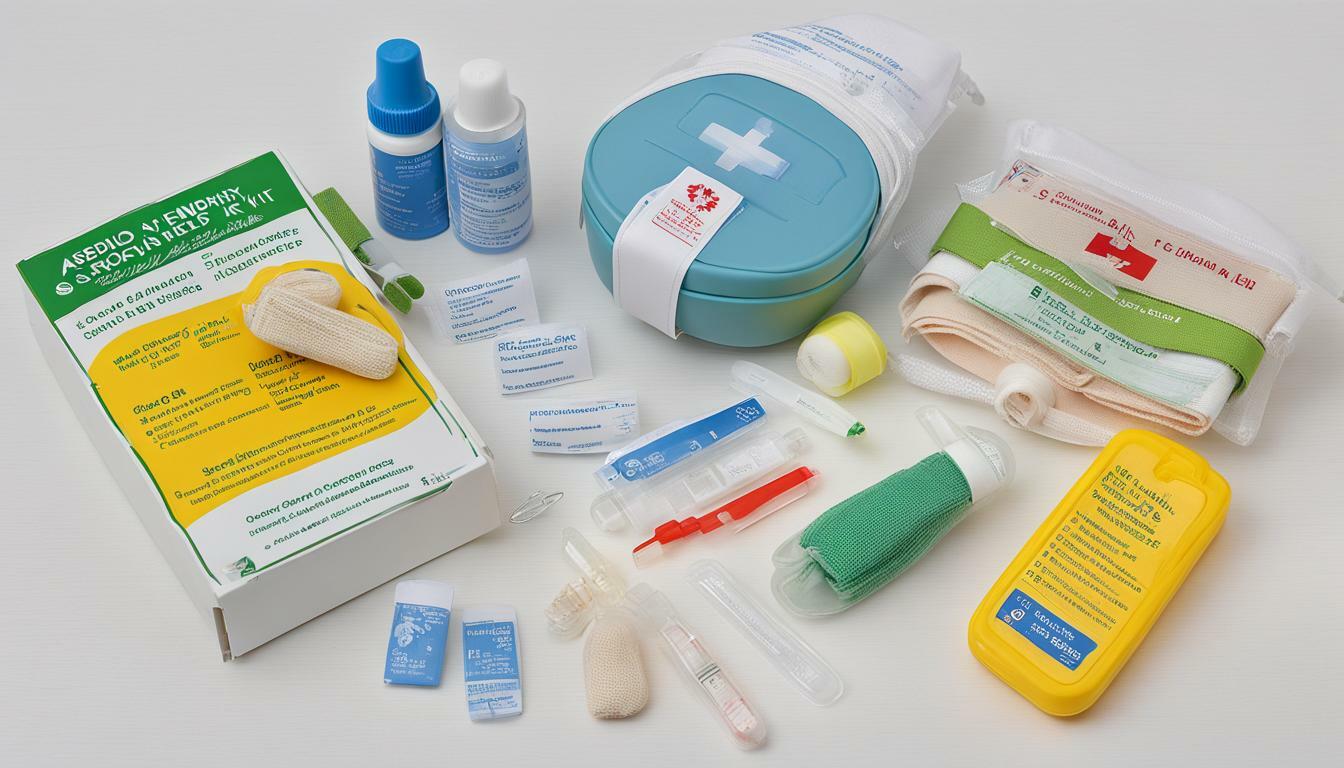As a new parent, your baby’s safety is your top priority, and the importance of having a first aid kit cannot be overstated. Accidents and emergencies can occur at any time, which is why it’s essential to be prepared with a well-stocked newborn safety kit.
First aid kits for babies come in different sizes and types, specifically designed to address common injuries and illnesses that babies may experience. From minor cuts and bruises to more severe medical emergencies, having a baby first aid kit can make all the difference in keeping your little one safe.
Whether you’re at home or on-the-go, having a baby emergency kit that includes essential infant first aid supplies is crucial for your baby’s health and safety. In this article, we will explore the importance of having a first aid kit for new parents, provide a checklist of essential items for a newborn first aid kit, and offer tips on how to choose, maintain, and inspect your baby first aid kit.
Key Takeaways:
- First aid kits for babies are specifically designed to address common injuries and illnesses that babies may experience.
- A baby emergency kit that includes essential infant first aid supplies is crucial for your baby’s health and safety.
- Choosing the right first aid kit for your baby, maintaining and inspecting it regularly, and seeking professional medical help when necessary are essential steps in caring for your baby’s safety.
Understanding the Need for a Baby First Aid Kit
As a new parent, the safety of your baby is a top priority. Accidents and emergencies can happen, and it’s crucial to be prepared with a well-stocked baby first aid kit. A baby first aid kit is specifically designed to cater to the needs of infants and young children, containing essential items that can help you handle common emergencies effectively.
Babies are particularly vulnerable to accidents, and it’s essential to be aware of potential hazards. As your baby grows and develops, their curiosity often leads them to explore their surroundings, which increases the likelihood of accidents. Additionally, infants and young children can experience health conditions that require prompt attention.
A newborn safety kit should include items such as bandages, gauze, adhesive tape, scissors, and a thermometer. Infant first aid supplies such as saline for cleaning wounds, a nasal aspirator for clearing nasal congestion, and a bulb syringe for suctioning are also essential items to include. It is important to ensure that all items in your baby emergency preparedness kit are sterile and suitable for infants.
It’s worth noting that different types of baby first aid kits are available, and the content may vary based on the manufacturer and the purpose. A basic baby first aid kit may include essentials such as bandages and antiseptic wipes, while a more comprehensive kit may contain a wide range of supplies, including medications and instruments.

When choosing a newborn first aid checklist, you should consider the age of your baby, their health conditions, and your travel requirements. For example, if you plan to travel with your baby, you may need a compact and portable first aid kit that is easy to carry. On the other hand, if your baby has a medical condition that requires specific medications, you may need to include these items in their first aid kit.
As a new parent, it’s essential to have basic first aid knowledge and a clear understanding of how to use the items in your baby first aid essentials kit. You should keep your baby first aid kit in a safe and easily accessible location, away from the reach of children. Regular inspections and restocking of your baby health and safety kit can ensure that it is always ready for use.
Choosing the Right First Aid Kit for Your Baby
When it comes to ensuring your little one’s baby health and safety, having a well-equipped baby emergency kit is crucial. However, with so many baby first aid essentials available, it can be overwhelming to select the right kit for your family.
Factors such as the age of your baby, travel requirements, and your baby’s specific health conditions should be considered when choosing a first aid kit. It’s important to select a kit that includes the necessary items for common emergencies such as cuts, scrapes, and burns, as well as any medications your baby may require.
Additionally, keep in mind the storage and accessibility of the kit. It should be easily accessible in case of an emergency, but also kept out of reach of children to avoid any accidents.
Consult with your healthcare provider or a certified first aid instructor for guidance on selecting the appropriate kit for your family’s needs. In the next section, we will cover the essential items for a newborn first aid kit.
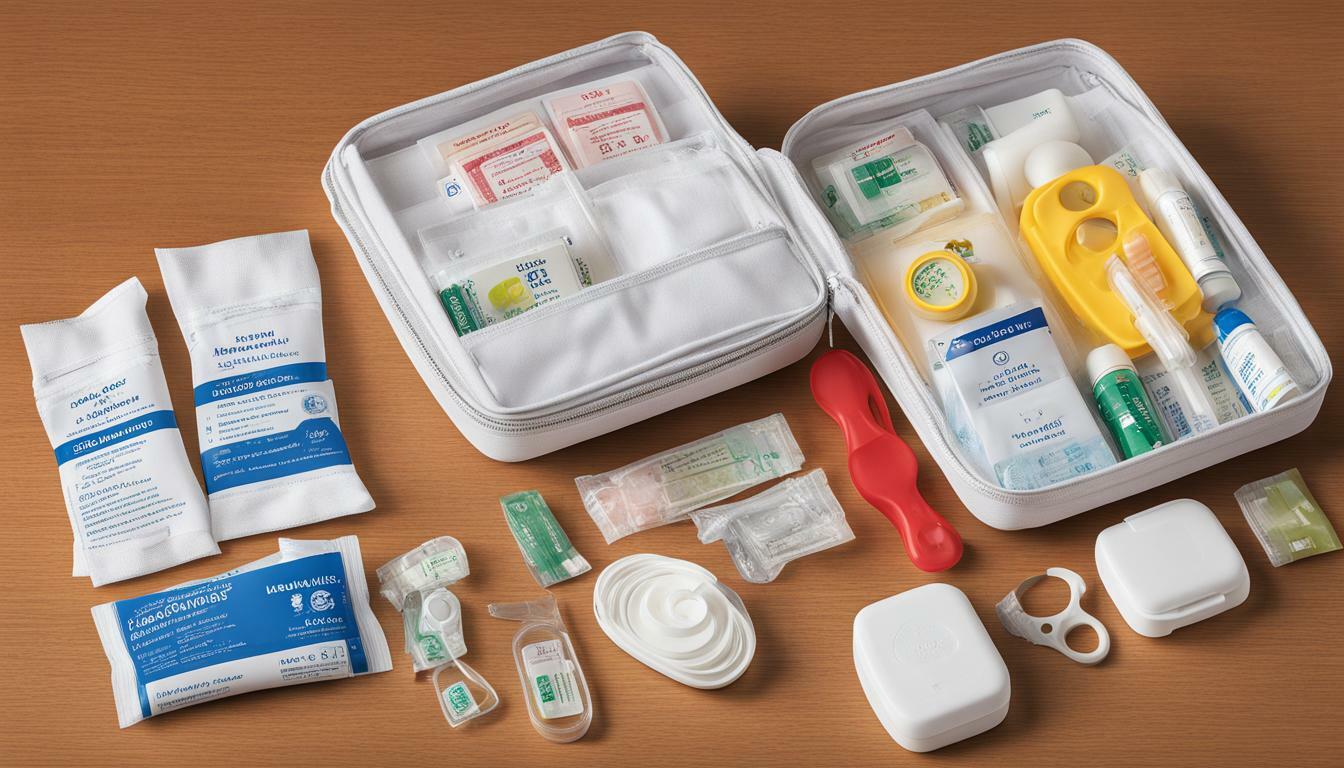
Essential Items for a Newborn First Aid Kit
As a new parent, having a well-stocked first aid kit is vital to ensure your baby’s safety. Here’s a comprehensive newborn first aid checklist that includes all the essential items you will need to handle common emergencies.
Bandages
Adhesive bandages or plasters in various sizes should be included in your baby first aid essentials. Make sure to have bandages suitable for sensitive skin and those that are waterproof to protect wounds from getting wet.
Thermometer
A rectal thermometer is recommended for infants as it provides the most accurate temperature reading. Make sure to have a backup thermometer in case the first one is lost or damaged.
Saline solution and bulb syringe
Saline solution is useful in cleaning your baby’s eyes, nose, and ears. A bulb syringe can help remove mucus from your baby’s nose, making it easier for your baby to breathe.
Medications
Include medications that are suitable for infants such as acetaminophen or ibuprofen for fever and pain relief. Don’t forget to consult your doctor before giving any medication to your baby.
Gloves and scissors
Gloves can help prevent the spread of infection, while scissors are useful in cutting bandages and clothing in case of an emergency.
Tape
Medical tape is useful in securing bandages and other items in place. Make sure to have tape suitable for sensitive skin.
Cotton balls and swabs
Cotton balls and swabs can be used to clean wounds or apply medications. Make sure to get soft and gentle ones suitable for babies.
Antibacterial ointment
Include an antibacterial ointment such as Neosporin to prevent infections in cuts, scrapes, or other wounds.
Emergency contact information and instructions
It’s important to have emergency contact information and instructions readily available in case of an emergency. Include important phone numbers such as your pediatrician, poison control centre, and emergency services. You can also include a first aid manual with basic instructions and guidelines.
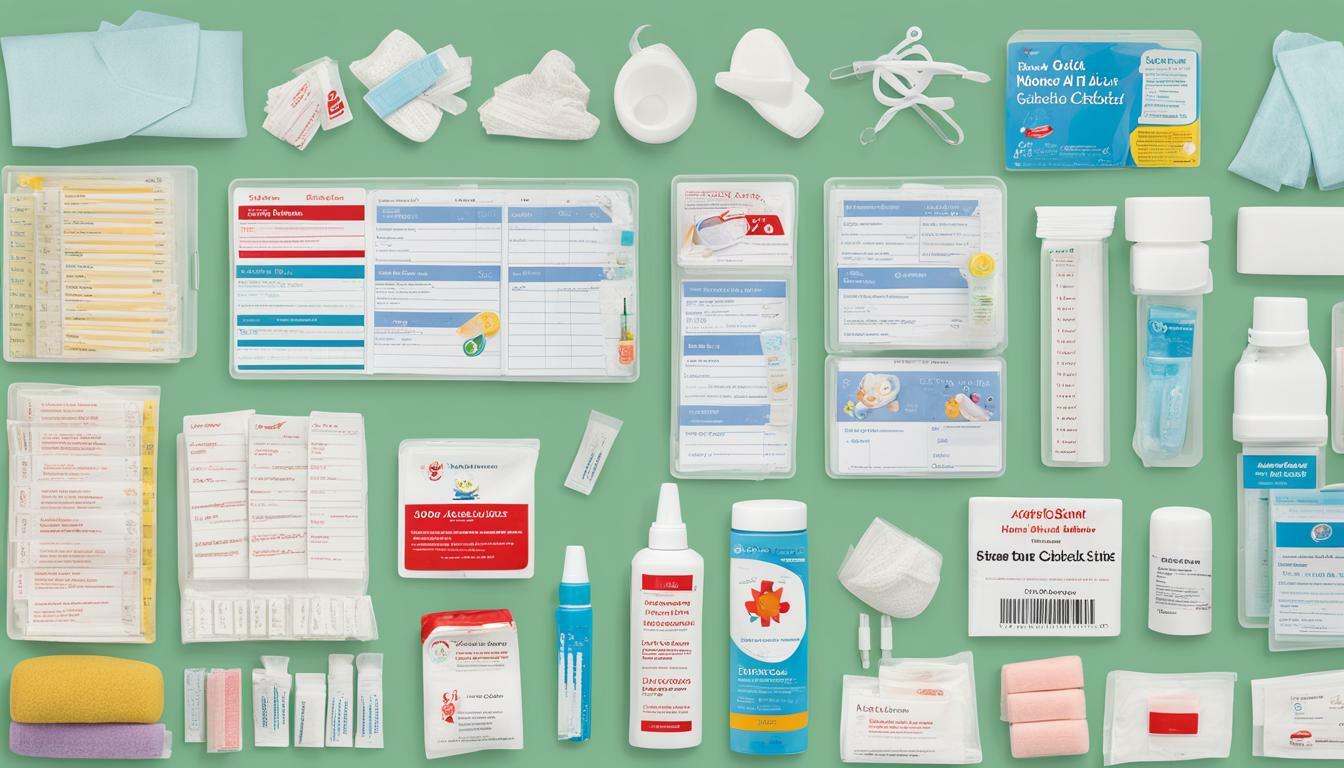
Essential Items for a Newborn First Aid Kit
When it comes to your baby’s health and safety, being prepared is key. Assembling a well-stocked first aid kit can help you handle common emergencies and give you peace of mind. Here are some essential items to include in your newborn safety kit:
| Item | Purpose |
|---|---|
| Thermometer | To monitor your baby’s temperature in case of a fever |
| Baby-safe pain relief medication | To help relieve pain associated with teething or fever |
| Saline solution | To clean and moisten your baby’s nose in case of congestion |
| Bandages and gauze pads | To cover cuts and wounds and stop bleeding |
| Antibiotic ointment | To prevent infection from cuts, scrapes or burns |
| Tweezers | To remove splinters or debris |
| Instant ice pack | To reduce swelling and inflammation |
| Scissors | To cut gauze or clothing in an emergency |
| Hand sanitizer | To keep your hands clean when administering first aid |
| Emergency contact list | To quickly access important phone numbers in case of an emergency |
Remember to regularly check the expiration dates on medications and replace any expired or damaged items. Keep your baby first aid kit in a cool, dry place that is easily accessible in case of an emergency.
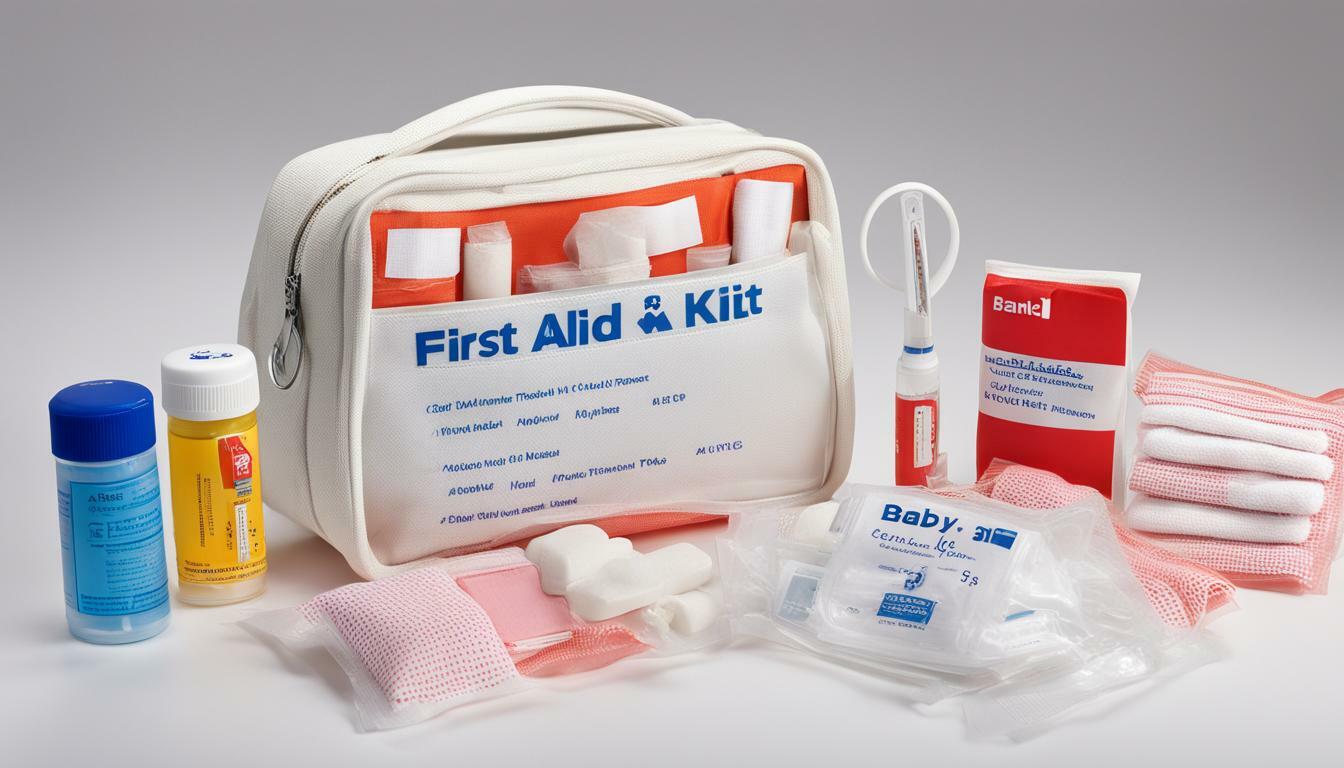
Having a well-stocked newborn first aid kit can provide you with peace of mind and confidence in handling common emergencies. However, it’s important to not only have the supplies but also the knowledge of how to use them. Consider taking a baby first aid course to learn basic first aid skills and infant CPR. Your baby’s health and safety are worth the investment.
Next up, we will discuss tips for maintaining and inspecting your baby first aid kit to ensure that you are always prepared for any situation.
Baby First Aid Training and Resources
Knowing how to use the items in your baby emergency kit is essential in responding to urgent situations. While some basic first aid knowledge is necessary, specific baby first aid training can provide valuable skills to help you react calmly and confidently.
Organizations such as the British Red Cross and St John Ambulance offer baby first aid courses for parents and caregivers. Courses cover essential skills such as choking relief, CPR, and identifying common childhood illnesses. These courses may also provide you with valuable resources such as first aid manuals and emergency contact cards.
There are also numerous online resources available to help you learn essential baby first aid skills. Websites like the NHS and the Royal Life Saving Society UK offer free online guides and videos covering topics such as CPR and baby choking relief.
Mobile apps such as Baby and Child First Aid and the Red Cross Baby and Child First Aid app can also provide invaluable guidance in emergencies. These apps offer step-by-step instructions, interactive quizzes, and videos to help you learn and practice life-saving skills.
By investing time in learning these essential skills, you can become better prepared in case of an emergency. Infant first aid supplies, combined with the knowledge of how to use them, are essential tools that every parent should have in their baby emergency preparedness kit.
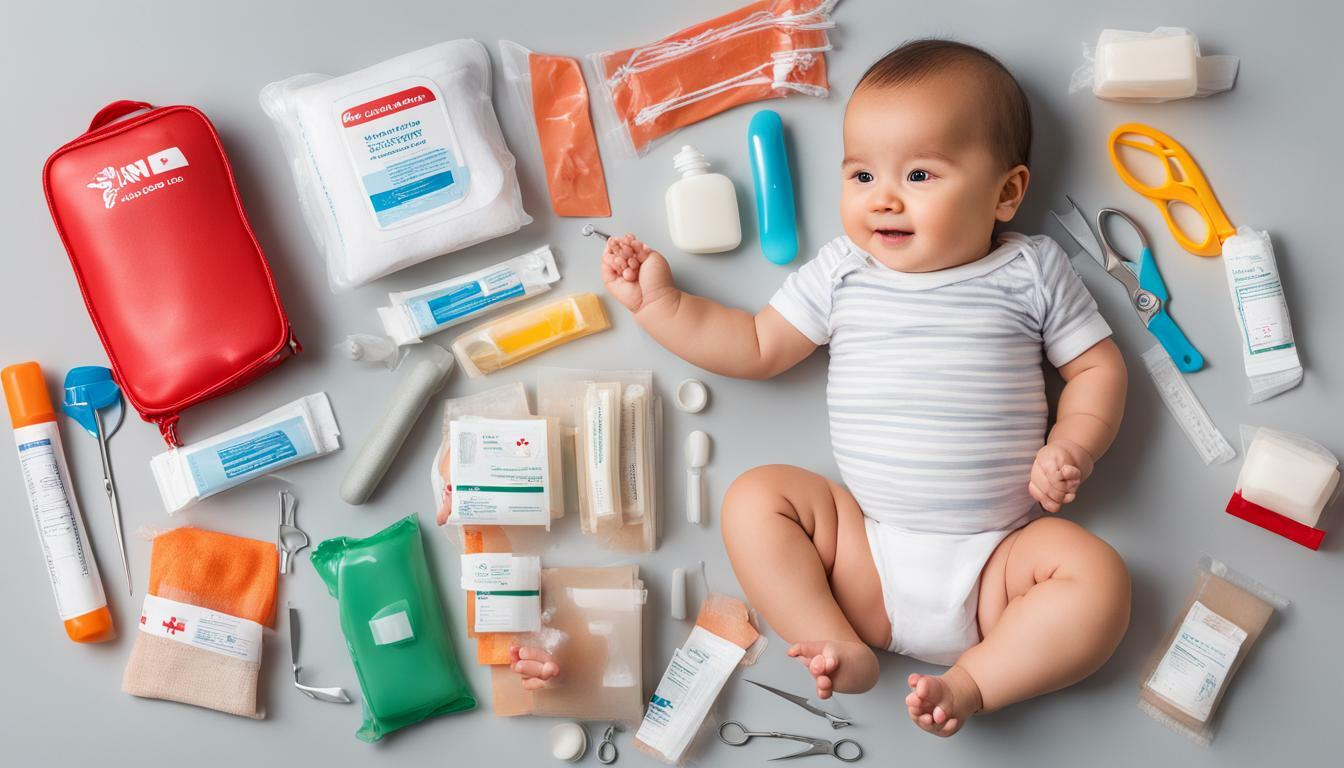
Additional Baby Safety Measures
Ensuring your baby’s health and safety goes beyond having a well-stocked newborn safety kit or baby emergency preparedness plan. Here are some additional measures you can take to create a safe environment for your little one:
- Babyproof your home: Babies are naturally curious and love to explore their surroundings. It’s essential to babyproof your home by covering electrical outlets, securing cabinets and drawers, and blocking access to stairs.
- Safe sleep practices: To reduce the risk of sudden infant death syndrome (SIDS), experts recommend placing your baby on their back to sleep with no blankets or pillows in the crib.
- Preventing common accidents: Be mindful of potential hazards such as hot liquids, sharp objects, and choking hazards. Keep harmful substances out of reach and teach older siblings to handle the baby gently.
By implementing these additional safety measures, you can create a secure and healthy environment for your baby to thrive in.
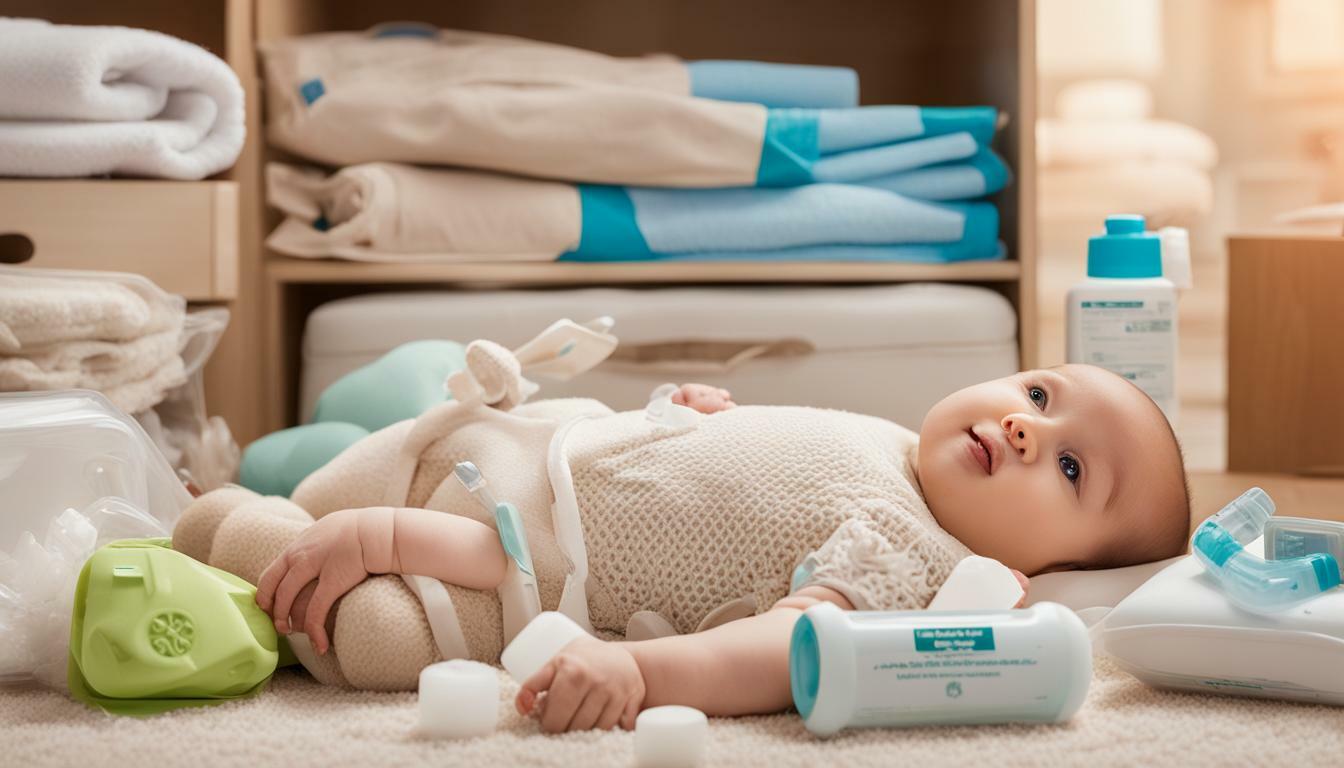
When to Seek Professional Medical Help
As a new parent, it’s important to know when to seek professional medical help for your baby. While having a well-stocked newborn safety kit and baby emergency kit is essential, there are certain situations where immediate medical attention is required. It’s important to stay calm and act quickly when faced with a medical emergency.
If your baby is experiencing any of the following symptoms, seek medical assistance immediately:
- Difficulty breathing
- Unconsciousness or unresponsiveness
- Severe bleeding
- Seizures
- Choking
- High fever (above 38°C)
- Head injuries resulting in loss of consciousness
In addition, any other symptoms that concern you as a parent should also be brought to the attention of a healthcare professional. It’s better to be safe than sorry when it comes to the health and safety of your baby.
Remember to consult your newborn first aid checklist or baby emergency kit for guidance on how to handle the situation until professional medical help arrives.
Conclusion
As a new parent, ensuring the safety and well-being of your precious little one is of the utmost importance. By investing in a well-stocked first aid kit specifically designed for babies, you can have peace of mind knowing you’re prepared for any potential emergencies.
Remember to choose the appropriate first aid kit for your baby based on their age, specific health conditions, and travel requirements. Regularly inspect and restock your kit, and store it in a safe, easily accessible place.
But having a first aid kit is just one aspect of baby safety. It’s essential to take other measures to create a safe environment for your baby, such as babyproofing your home, safe sleep practices, and preventing common accidents. Also, ensure you know when to seek professional medical help and how to handle emergencies until help arrives.
Finally, don’t forget about baby first aid training programmes and resources. Learning basic first aid, infant CPR, and choking relief techniques can make all the difference in an emergency situation.
Overall, prioritising your baby’s safety is the best gift you can give as a parent. Equip yourself with the necessary tools and knowledge to handle any situation effectively, and enjoy the beautiful journey of parenthood with confidence.
